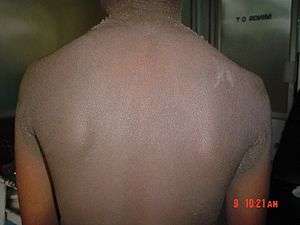Hyperpigmentation
| Hyperpigmentation | |
|---|---|
 | |
| Classification and external resources | |
| Specialty | Dermatology |
| ICD-10 | L81.0-L81.4 |
| ICD-9-CM | 709.0 |
| DiseasesDB | 24638 |
| MeSH | D017495 |
Hyperpigmentation is the darkening of an area of skin or nails caused by increased melanin.
Causes
Hyperpigmentation can be caused by sun damage, inflammation, or other skin injuries, including those related to acne vulgaris.[1] People with darker Asian, Mediterranean, or African skin tones are more prone to hyperpigmentation, especially with excess sun exposure.
Many forms of hyperpigmentation are caused by an excess production of melanin. Hyperpigmentation can be diffuse or focal, affecting such areas as the face and the back of the hands. Melanin is produced by melanocytes at the lower layer of the epidermis. Melanin is a class of pigment responsible for producing color in the body in places such as the eyes, skin, and hair. As the body ages, melanocyte distribution becomes less diffuse and its regulation less controlled by the body. UV light stimulates melanocyte activity, and where concentration of the cells is greater, hyperpigmentation occurs. Another form of hyperpigmentation is post inflammatory hyperpigmentation. These are dark and discolored spots that appear on the skin following acne that has healed.[2]
Hyperpigmentation is associated with a number of diseases or conditions, including the following:
- Addison's disease and other sources of adrenal insufficiency, in which hormones that stimulate melanin synthesis, such as melanocyte-stimulating hormone (MSH), are frequently elevated.
- Cushing's disease or other excessive adrenocorticotropic hormone (ACTH) production, because MSH production is a byproduct of ACTH synthesis from proopiomelanocortin (POMC).
- Acanthosis nigricans – hyperpigmentation of intertriginous areas associated with insulin resistance.
- Melasma, also known as chloasma – patchy hyperpigmentation often found in pregnant women.
- Linea nigra – a hyperpigmented line found on the abdomen during pregnancy.
- Peutz-Jeghers syndrome – an autosomal dominant disorder characterized by hyperpigmented macules on the lips and oral mucosa and gastrointestinal polyps.
- Exposure to certain chemicals such as salicylic acid, bleomycin, and cisplatin.
- Smoker's melanosis
- Celiac disease
- Cronkite-Canada syndrome
- Porphyria
- Tinea fungal infections such as ringworm
- Haemochromatosis - a common but debilitating genetic disorder characterized by the chronic accumulation of iron in the body.
- Mercury poisoning - particularly cases of cutaneous exposure resulting from the topical application of mercurial ointments or skin-whitening creams.
- Aromatase deficiency
- Nelson's syndrome
- Grave's disease
- As a result of tinea cruris.
Hyperpigmentation can sometimes be induced by dermatological laser procedures.
Treatment
Treatment of hyperpigmentation may include hydroquinone, kojic acid, alpha hydroxy acids, azelaic acid, ascorbic acid, tretinoin (Retinol), topical glucocorticoids, and licorice extract. Sunscreen may help to prevent these dark spots.
See also
References
- ↑ "Hyperpigmentation". Dermatalogic Disease Database. American Osteopathic College of Dermatology. Retrieved 2006-03-08.
- ↑ Hyperpigmentation on Face (Acne Scars} Hyperpigmentation, Dark Spots, Acne Scars, Meladerm".
External links
| Wikimedia Commons has media related to Acne. |